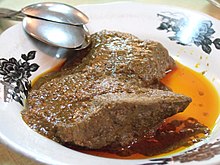"Rendang"
Rendang is a spicy meat dish which originated from the Minangkabau ethnic group of Indonesia,[1] and is now commonly served across the country.[2] One of the characteristic foods of Minangkabau culture, it is served at ceremonial occasions and to honour guests.[3] Rendang is also served among the Malay community in Malaysia, Singapore, Brunei and Southern Philippines. Rendang is traditionally prepared by the Minangkabau community during festive occasions such as traditional ceremonies, wedding feasts and Hari Raya (Eid al-Fitr). Culinary experts often describe rendang as: ‘West Sumatran caramelised beef curry’.[1][4] In 2011 an online poll by 35,000 people held by CNN International chose rendang as the number one dish of their ‘World's 50 Most Delicious Foods (Readers' Pick)’ list.[5]
Composition and cooking method
The cooking technique flourished because of its role in preserving meat in a tropical climate.[6] Prior to refrigeration technology, this style of cooking enabled preservation of the large amount of meat.[7] Rendang is rich in spices. Along with the main meat ingredient, rendang uses coconut milk (Minangkabau: karambia) and a paste of mixed ground spices, which includes ginger, galangal, turmeric leaves, lemongrass, garlic, shallot, chilli and other spices. This spice mixture is called ‘pemasak’ in Minangkabau. The spices, garlic, shallot, ginger and galangal used in rendang have antimicrobial properties and serve as natural organic preservatives.[8] If cooked properly, dry rendang can last for as long as four weeks.[4]Traditionally the term rendang in Minangkabau language does not refer to a certain type of dish. The verb merendang actually refers to a cooking method of slow cooking; continuously churning the ingredients in a pot or frying pan, on a small fire, until all of the liquids evaporate and the meat is well done.[9] Traditional Padang rendang takes hours to cook. Cooking rendang involves pounding and grinding ingredients as well as slow cooking, and so is time-consuming and requires patience.[10] The meat pieces are slowly cooked in coconut milk and spices until almost all the liquid is gone, allowing the meat to absorb the condiments. The cooking process changes from boiling to frying as the liquid evaporates. The slow cooking process allows the meat to absorb all the spices and become tender.[11] To cook the meat until tender with almost all the liquid evaporated requires great care, if the meat is not to be burnt or spoilt. Because of its generous use of numerous spices, rendang is known for having a complex and unique taste.
Rendang is often served with steamed rice, ketupat (a compressed rice cake) or lemang (glutinous rice cooked in bamboo tubes), accompanied with vegetable side dishes such as boiled cassava leaf, cubadak[12] (young jackfruit gulai), cabbage gulai and lado (red or green chilli pepper sambal).
Variations
Rendang is made from beef (or occasionally beef liver, chicken, mutton, water buffalo, duck, or vegetables like jackfruit or cassava). Chicken or duck rendang also contains tamarind and is usually not cooked for as long as beef rendang.[21]The original Indonesian-Minangkabau rendang has two categories, rendang darek and rendang pesisir. Rendang darek (‘land rendang’) is an umbrella term for dishes from old regions in mountainous areas of Minangkabau such as Batusangkar, Agam, Lima Puluh Kota, Payakumbuh, Padang Panjang and Bukittinggi. It mainly consists of beef, offal, poultry products, jackfruit, and many other vegetables and animal products which are found in these places. Rendang pesisir (‘coastal rendang’) is from the coastal regions of Minangkabau such as Pariaman, Padang, Painan and Pasaman. Rendang pesisir mainly consists of seafood, although it is not unusual for them to incorporate beef or water buffalo meat in their rendang.
Indonesian Rendang variations:[6]
- Rendang daging: meat rendang. The most common rendang is made from beef, but may also be from water buffalo, goat, mutton or lamb, speciality of Padang.
- Rendang ayam: chicken rendang, speciality of Batusangkar and Bukittinggi.
- Rendang baluik (rendang belut): eel rendang, speciality of Solok. In the Solok dialect, it is also called ‘randang baluk’.
- Rendang cubadak (rendang nangka): jackfruit rendang, speciality of Payakumbuh.
- Rendang hati: cow's liver rendang, speciality of Minangkabau.
- Rendang itiak (rendang bebek): duck rendang, speciality of Bukittinggi.
- Rendang jamur: mushroom rendang
- Rendang jantung pisang: banana blossom rendang, speciality of Minangkabau.
- Rendang jariang (rendang jengkol): jengkol rendang, speciality of Bukittinggi.
- Rendang jo kantang: beef rendang with baby potatoes, speciality of Kapau.
- Rendang lokan (rendang tiram): marsh clam rendang, speciality of coastal regions of Minangkabau, such as Pariaman, Painan and Pesisir Selatan.
- Rendang paru: cow's lung rendang, speciality of Payakumbuh.
- Rendang pucuak ubi (rendang daun singkong): cassava leaves rendang, speciality of Minangkabau.
- Rendang runtiah (rendang suir): shredded beef or poultry rendang, speciality of Payakumbuh.
- Rendang tahu: tofu rendang, speciality of Minangkabau.
- Rendang talua (rendang telur): egg rendang, speciality of Payakumbuh.

Tidak ada komentar:
Posting Komentar